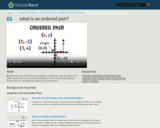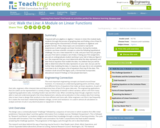
In this tutorial, you'll see how to solve a system of inequalities by graphing both inequalities and finding their intersection. [5:54]
- Subject:
- Mathematics
- Material Type:
- Audio/Video
- Provider:
- Virtual Nerd
- Date Added:
- 10/01/2022

In this tutorial, you'll see how to solve a system of inequalities by graphing both inequalities and finding their intersection. [5:54]

Plotting points on the coordinate plane is the foundation of graphing equations. Before students can graph equations, get familiar with the coordinate plane here in this tutorial. [7:17]

This tutorial introduces ordered pairs and shows why they are a fundamental part of graphing. [2:20]

When you graph an inequality on the coordinate plane, you end up creating a boundary which cuts the plane in half. Learn about this boundary in this tutorial. [1:08]

Watch this tutorial to take a look at the scatter plot which is useful for graphically showing a bunch of data. [1:17]

Prepared with pre-algebra or algebra 1 classes in mind, this module leads students through the process of graphing data and finding a line of best fit while exploring the characteristics of linear equations in algebraic and graphic formats. Then, these topics are connected to real-world experiences in which people use linear functions. During the module, students use these scientific concepts to solve the following hypothetical challenge: You are a new researcher in a lab, and your boss has just given you your first task to analyze a set of data. It being your first assignment, you ask an undergraduate student working in your lab to help you figure it out. She responds that you must determine what the data represents and then find an equation that models the data. You believe that you will be able to determine what the data represents on your own, but you ask for further help modeling the data. In response, she says she is not completely sure how to do it, but gives a list of equations that may fit the data. This module is built around the legacy cycle, a format that incorporates educational research feindings on how people best learn.

Use real-time data to study factors that affect weather and climate, create weather instruments, and share data with students around the world.

Students first explore different materials to see what types reduce the most amount of sound when placed in a box. Each group is assigned a different material and they fill their box with that specific material. Students measure the sound level of a tone playing from inside the box using a decibel reader from outside the box. Students share this data with the class and analyze which types of materials absorb the most sound and which reflect the most sound.